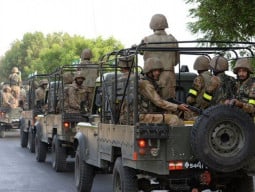
The drop scene of the encounter with the organised criminal gang in the Rajanpur district has raised more questions than it has answered about the capacity, wherewithal and sense of application of our law enforcement agencies. Did the assorted force of over 2,000 gathered from varied jurisdictions have adequate understanding of the terrain and familiarity with the hideouts? Were the frontline officials adequately protected with bulletproof jackets and safety headgears? Was the strike force equipped with precision-guided ammunition? Has there ever been any accountability of aborted operations in previous years? And what was the result of that accountability? The Rajanpur operation saw the loss of precious lives of police officials, as well as 24 officials being taken hostage by the gang with ease. They were used as human shields, thwarting any further moves from the police. Launching of the operation by the provincial police with this kind of preparedness calls for a critique, more so in the backdrop of the government claiming that there were no no-go areas in Punjab.
The existence of organised criminal gangs is not unknown in the riverine belt of Punjab and Sindh. They have been surging and hibernating in response to the will and resolve of the law enforcement agencies to nab them. The local police has always faced innate difficulties in dealing with these gangs in view of the meandering and seasonally swelling rivers, which hamper the launch of successful operations. Riverbanks, coinciding with district boundaries, have been causing inter-jurisdictional problems along with logistical difficulties. Lack of resources and manpower at rural police stations further raise capacity-related issues. Operations in these areas are carried out by calling in forces from other parts of the district, which often do not have complete understanding of the terrain. As a result, a modicum of co-existence persists between the criminal gangs and the local police. The gangsters tend to stay away from the settled areas while the district police has no qualms staying away from the daily chores and activities of the criminals in the ungoverned spaces. These places are left to the devices of ‘chottus’ and their ilk, who foist their own system of justice while claiming a share of the local produce. Ingress by either side is treated as a breach of tacit understanding, which gives rise to a chain reaction. Episodic operations are conducted without long-term results and the scourge keeps persisting.Rassagiri, cattle-lifting, is now accompanied by far more complex and heinous crimes of extortion and kidnapping for ransom. Even if these criminal elements do not receive any tacit support, they do not face any resistance either from the local police or from influential power holders. At times, the police and the power holders have a share in the pie.
The Chottu gang did not drop from the heavens. It had a history of existence in the riverine areas. There is adequate evidence to suggest a strong nexus between criminal elements, local power wielders and levers of state power at the grass-root level. The relative passivity of rural folk, their social and physical vulnerability, has only led to greater dependence on the triple centres of power, namely, the criminals, local influentials and the police. This has further strengthened the grip of power wielders on the passive populace. As a result, a unique system of justice and retribution has spawned in these ungoverned spaces. To illustrate the above, let me recount an incident from when I was posted in a rural subdivision in southern Punjab many years ago. I recall a police inspector being severely reprimanded by a no-nonsense inspector-general of police on account of rising incidents of theft and poor recovery of stolen property. The beleaguered inspector approached a local political figure to bail him out. The officer was readily obliged by the political figure through a surreptitious plan. The local influential offered his newly bought tractor to be ‘stolen’ for which the service of a professional thief was engaged. The ‘theft’ was affected and an FIR was filed accordingly. After a week or so, recovery was made and the so-called accused was arrested and sent to the judicial lock-up. After an interlude of a few days, as the dust settled, the bail of the 'culprit' was secured from court. Within a month, recovery of stolen property had shown appreciable improvement in monetary terms.
In 2003-04, the federal government moved in a big way to secure the area at the tri-junction of Sindh, Punjab and Balochistan. The plan was prepared and a substantial allocation was made to set up permanent checkposts, manpower was raised, and arrangements for training, equipment and transport of the police were made. The scheme took off but somewhere along the line, it was hit by snags and the political support whittled down. Criminals have been operating in the areas of Bangla Ichcha and Sonmiani in the Rajanpur district, and in Bhong and Machka in Rahimyar Khan since the 1980s. Machka, an enclave of Punjab surrounded by areas of Sindh, presents an interesting history. It has a sizeable, well-to-do, highly educated Hindu population, which had been the victim of kidnappings for ransom that had been going on for many years without a permanent solution. The victim's family has no choice but to arrange the ransom money and the victim is quietly delivered. He is warned not to utter a single word about the captors and the mode of his delivery. The final deal was often struck through the channels provided by the local political influentials and the police. In the good old days, Machka had been a shikargah of the Mirs of Khairpur, which was gifted to the Nawab of Bahawalpur and became a part of the princely state. After the break-up of One Unit, it became a part of Punjab but retained strong cultural and familial ties with Sindh.
In Pakistan, the police, as an instrument of enforcement, was traditionally geared towards rural policing where the vast majority of the country resided in days past. It had a strong element of community support. The rural police station in the good old days presented the image of the state and its functionaries were looked at with awe and reverence. Over time, policing in Pakistan has become urban-centric. There has been very heavy investment in urban policing both in terms of modernisation and induction of specialised streams. We have the traffic police, the Rapid Deployment Force, the Elite Force, the counterterrorism force and now the Dolphin force, which are all urban-centric. This has been at the expense of rural policing where the station house officer continues to look towards the robbed complainant for reams of stationery and a few litres of petrol before taking action on his complaint. There is a need to rebalance spending to give proper priority to rural policing. Training on a continuous basis has suffered noticeable neglect. What is needed is a well-defined regime of periodical training and upgradation of professional skills at each level.
Published in The Express Tribune, May 3rd, 2016.
Like Opinion & Editorial on Facebook, follow @ETOpEd on Twitter to receive all updates on all our daily pieces.
































































COMMENTS (3)
Comments are moderated and generally will be posted if they are on-topic and not abusive.
For more information, please see our Comments FAQ